Blockchain Technology: Architecture, Features, and Applications
VerifiedAdded on 2021/06/15
|10
|2538
|12
Report
AI Summary
This report provides a comprehensive overview of blockchain technology, delving into its architecture, key features, and various applications. It begins by examining the foundational elements of blockchain, including its decentralized architecture, the structure of blocks, and the mechanisms ensuring secure transactions. The report then explores the core features of blockchain, such as decentralization, persistency, anonymity, and auditability. Furthermore, it addresses the challenges associated with blockchain, including scalability issues, privacy risks, and the potential for selfish mining. The report then shifts its focus to the practical applications of blockchain, particularly in the realm of cryptocurrency, with a detailed look at Bitcoin, and in the development of smart contracts. Finally, the report touches on the socio-technical aspects of blockchain, highlighting the impact of Bitcoin and smart contracts on transaction processing and the need for trust in emerging technologies. The report concludes by summarizing the key findings and emphasizing the growing importance of blockchain in the evolving digital landscape.
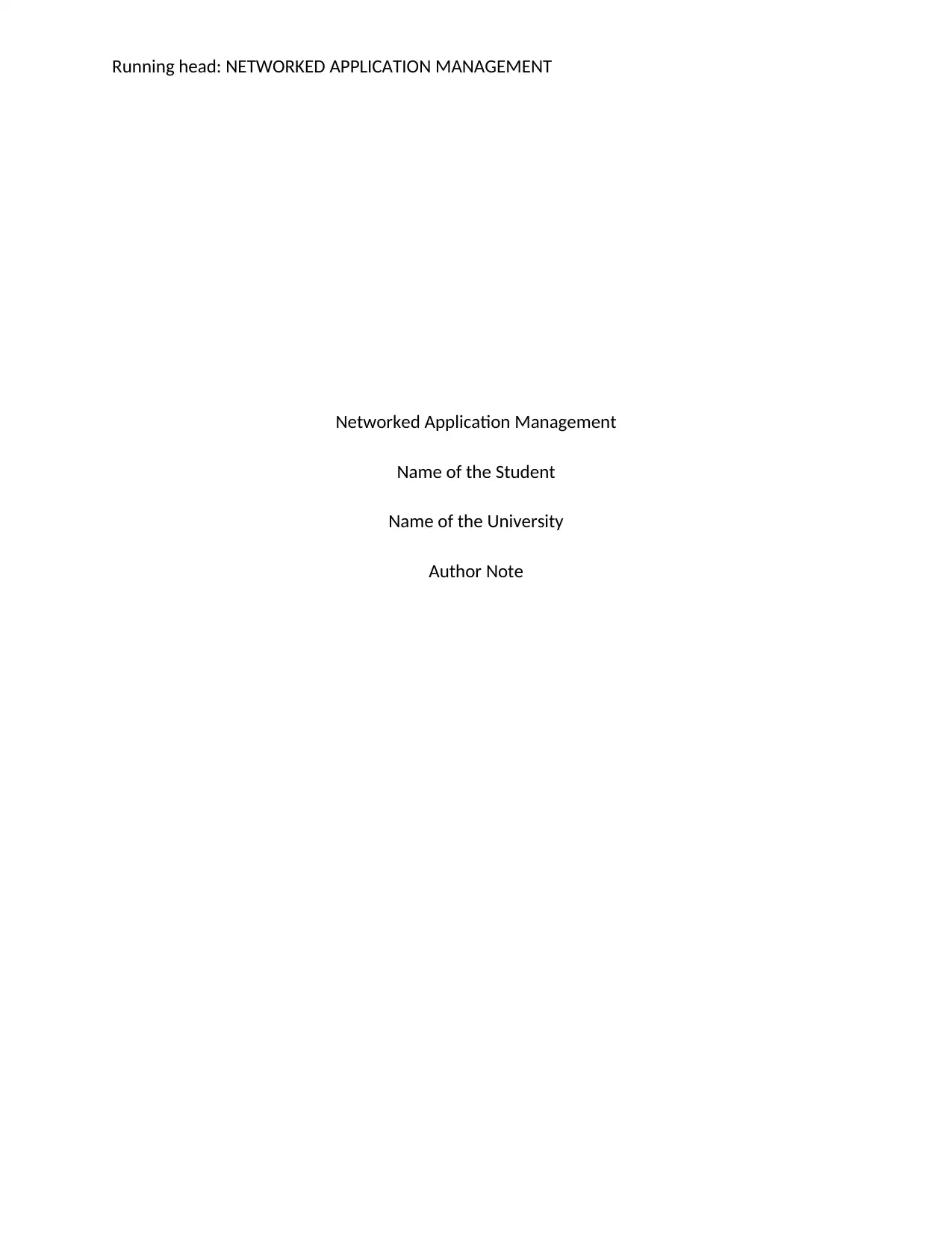
Running head: NETWORKED APPLICATION MANAGEMENT
Networked Application Management
Name of the Student
Name of the University
Author Note
Networked Application Management
Name of the Student
Name of the University
Author Note
Paraphrase This Document
Need a fresh take? Get an instant paraphrase of this document with our AI Paraphraser
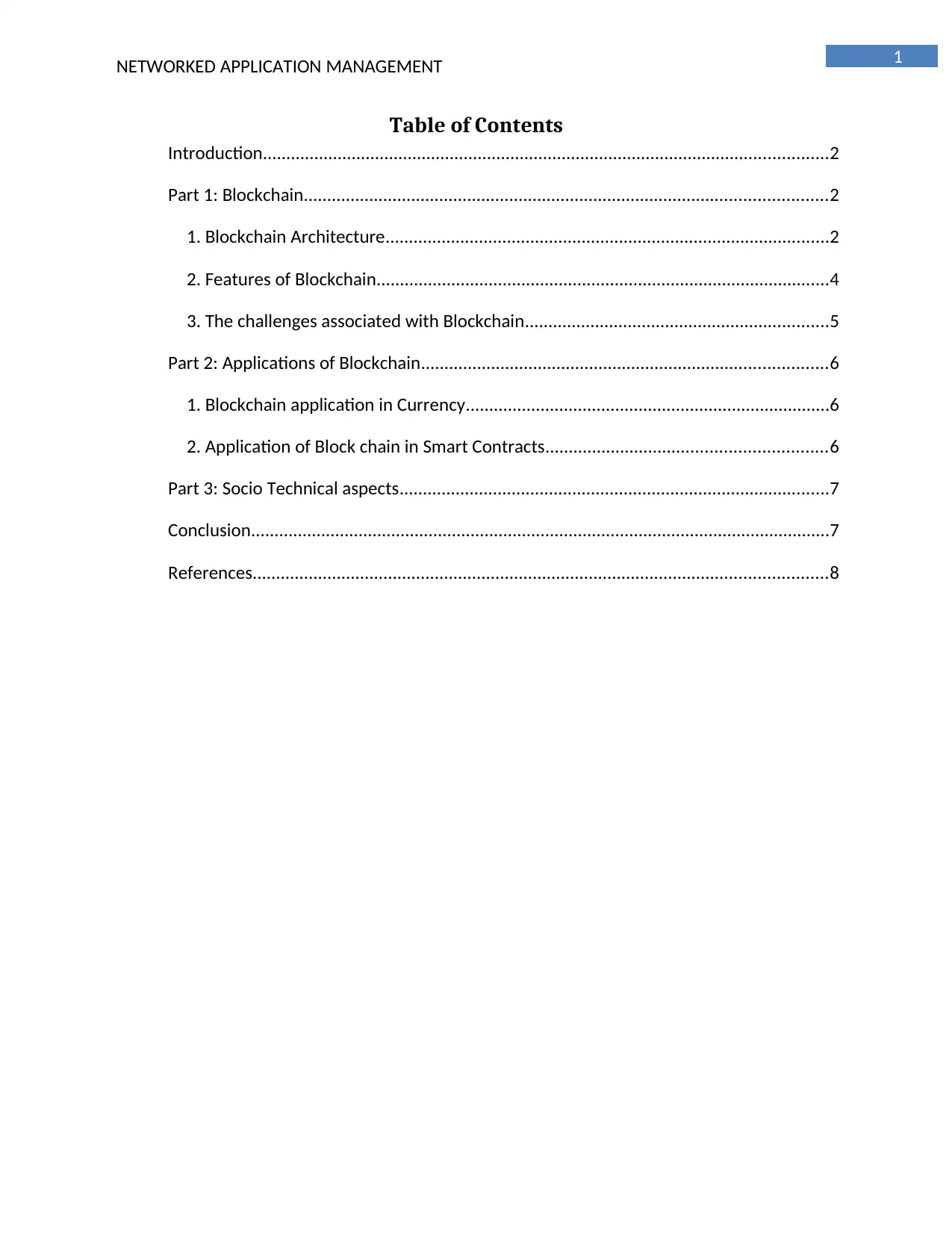
1
NETWORKED APPLICATION MANAGEMENT
Table of Contents
Introduction.........................................................................................................................2
Part 1: Blockchain................................................................................................................2
1. Blockchain Architecture...............................................................................................2
2. Features of Blockchain.................................................................................................4
3. The challenges associated with Blockchain.................................................................5
Part 2: Applications of Blockchain.......................................................................................6
1. Blockchain application in Currency..............................................................................6
2. Application of Block chain in Smart Contracts............................................................6
Part 3: Socio Technical aspects............................................................................................7
Conclusion............................................................................................................................7
References...........................................................................................................................8
NETWORKED APPLICATION MANAGEMENT
Table of Contents
Introduction.........................................................................................................................2
Part 1: Blockchain................................................................................................................2
1. Blockchain Architecture...............................................................................................2
2. Features of Blockchain.................................................................................................4
3. The challenges associated with Blockchain.................................................................5
Part 2: Applications of Blockchain.......................................................................................6
1. Blockchain application in Currency..............................................................................6
2. Application of Block chain in Smart Contracts............................................................6
Part 3: Socio Technical aspects............................................................................................7
Conclusion............................................................................................................................7
References...........................................................................................................................8
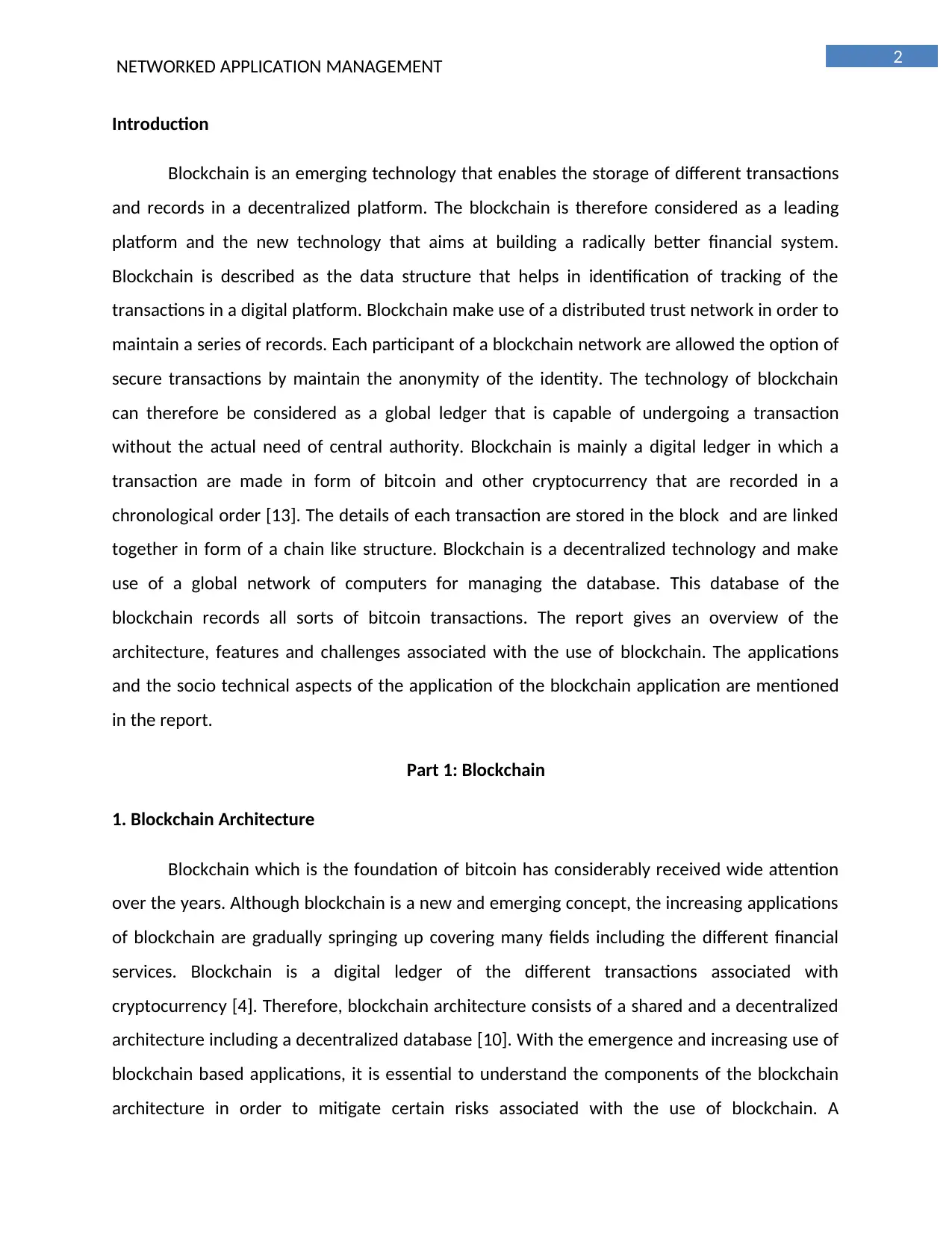
2
NETWORKED APPLICATION MANAGEMENT
Introduction
Blockchain is an emerging technology that enables the storage of different transactions
and records in a decentralized platform. The blockchain is therefore considered as a leading
platform and the new technology that aims at building a radically better financial system.
Blockchain is described as the data structure that helps in identification of tracking of the
transactions in a digital platform. Blockchain make use of a distributed trust network in order to
maintain a series of records. Each participant of a blockchain network are allowed the option of
secure transactions by maintain the anonymity of the identity. The technology of blockchain
can therefore be considered as a global ledger that is capable of undergoing a transaction
without the actual need of central authority. Blockchain is mainly a digital ledger in which a
transaction are made in form of bitcoin and other cryptocurrency that are recorded in a
chronological order [13]. The details of each transaction are stored in the block and are linked
together in form of a chain like structure. Blockchain is a decentralized technology and make
use of a global network of computers for managing the database. This database of the
blockchain records all sorts of bitcoin transactions. The report gives an overview of the
architecture, features and challenges associated with the use of blockchain. The applications
and the socio technical aspects of the application of the blockchain application are mentioned
in the report.
Part 1: Blockchain
1. Blockchain Architecture
Blockchain which is the foundation of bitcoin has considerably received wide attention
over the years. Although blockchain is a new and emerging concept, the increasing applications
of blockchain are gradually springing up covering many fields including the different financial
services. Blockchain is a digital ledger of the different transactions associated with
cryptocurrency [4]. Therefore, blockchain architecture consists of a shared and a decentralized
architecture including a decentralized database [10]. With the emergence and increasing use of
blockchain based applications, it is essential to understand the components of the blockchain
architecture in order to mitigate certain risks associated with the use of blockchain. A
NETWORKED APPLICATION MANAGEMENT
Introduction
Blockchain is an emerging technology that enables the storage of different transactions
and records in a decentralized platform. The blockchain is therefore considered as a leading
platform and the new technology that aims at building a radically better financial system.
Blockchain is described as the data structure that helps in identification of tracking of the
transactions in a digital platform. Blockchain make use of a distributed trust network in order to
maintain a series of records. Each participant of a blockchain network are allowed the option of
secure transactions by maintain the anonymity of the identity. The technology of blockchain
can therefore be considered as a global ledger that is capable of undergoing a transaction
without the actual need of central authority. Blockchain is mainly a digital ledger in which a
transaction are made in form of bitcoin and other cryptocurrency that are recorded in a
chronological order [13]. The details of each transaction are stored in the block and are linked
together in form of a chain like structure. Blockchain is a decentralized technology and make
use of a global network of computers for managing the database. This database of the
blockchain records all sorts of bitcoin transactions. The report gives an overview of the
architecture, features and challenges associated with the use of blockchain. The applications
and the socio technical aspects of the application of the blockchain application are mentioned
in the report.
Part 1: Blockchain
1. Blockchain Architecture
Blockchain which is the foundation of bitcoin has considerably received wide attention
over the years. Although blockchain is a new and emerging concept, the increasing applications
of blockchain are gradually springing up covering many fields including the different financial
services. Blockchain is a digital ledger of the different transactions associated with
cryptocurrency [4]. Therefore, blockchain architecture consists of a shared and a decentralized
architecture including a decentralized database [10]. With the emergence and increasing use of
blockchain based applications, it is essential to understand the components of the blockchain
architecture in order to mitigate certain risks associated with the use of blockchain. A
⊘ This is a preview!⊘
Do you want full access?
Subscribe today to unlock all pages.

Trusted by 1+ million students worldwide
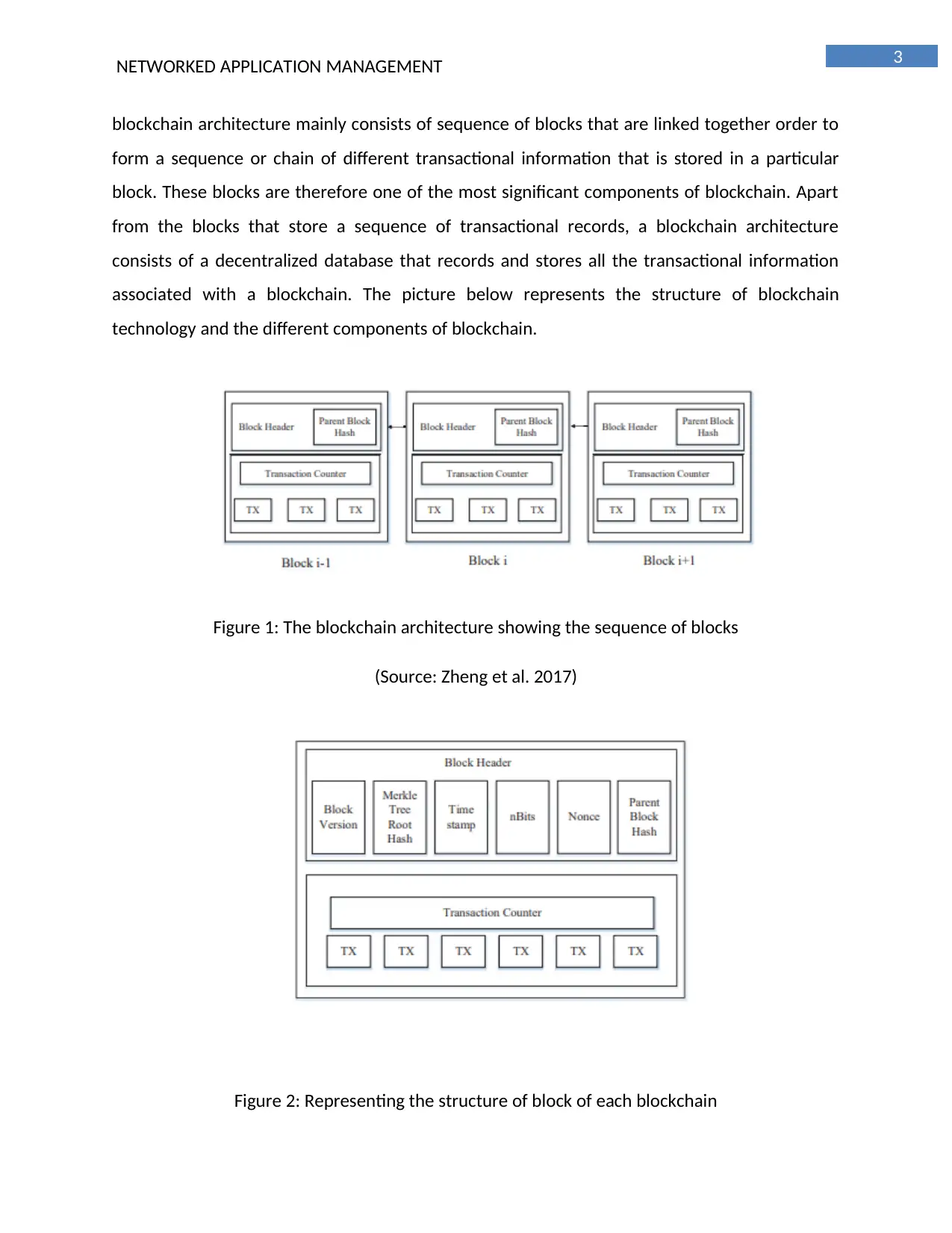
3
NETWORKED APPLICATION MANAGEMENT
blockchain architecture mainly consists of sequence of blocks that are linked together order to
form a sequence or chain of different transactional information that is stored in a particular
block. These blocks are therefore one of the most significant components of blockchain. Apart
from the blocks that store a sequence of transactional records, a blockchain architecture
consists of a decentralized database that records and stores all the transactional information
associated with a blockchain. The picture below represents the structure of blockchain
technology and the different components of blockchain.
Figure 1: The blockchain architecture showing the sequence of blocks
(Source: Zheng et al. 2017)
Figure 2: Representing the structure of block of each blockchain
NETWORKED APPLICATION MANAGEMENT
blockchain architecture mainly consists of sequence of blocks that are linked together order to
form a sequence or chain of different transactional information that is stored in a particular
block. These blocks are therefore one of the most significant components of blockchain. Apart
from the blocks that store a sequence of transactional records, a blockchain architecture
consists of a decentralized database that records and stores all the transactional information
associated with a blockchain. The picture below represents the structure of blockchain
technology and the different components of blockchain.
Figure 1: The blockchain architecture showing the sequence of blocks
(Source: Zheng et al. 2017)
Figure 2: Representing the structure of block of each blockchain
Paraphrase This Document
Need a fresh take? Get an instant paraphrase of this document with our AI Paraphraser
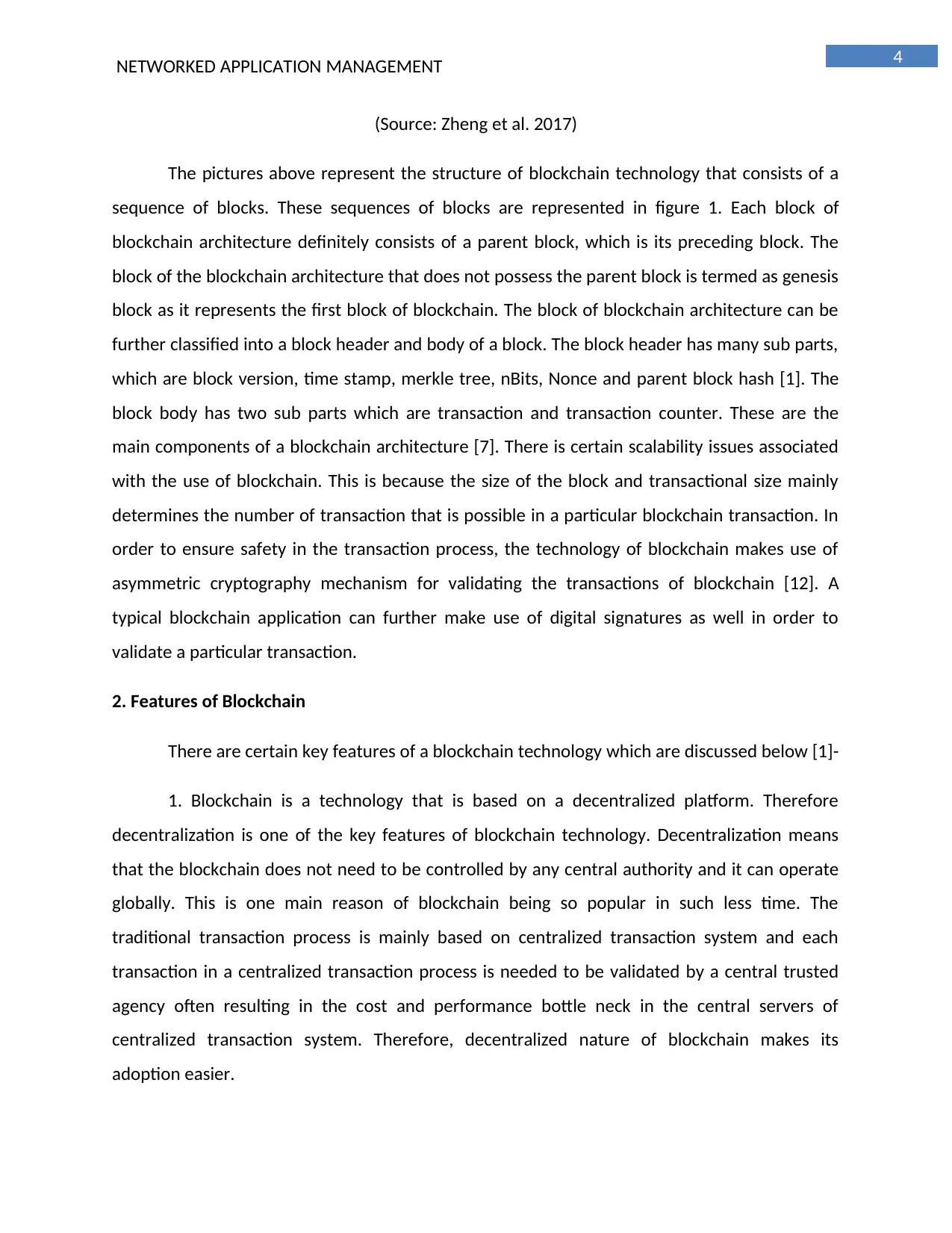
4
NETWORKED APPLICATION MANAGEMENT
(Source: Zheng et al. 2017)
The pictures above represent the structure of blockchain technology that consists of a
sequence of blocks. These sequences of blocks are represented in figure 1. Each block of
blockchain architecture definitely consists of a parent block, which is its preceding block. The
block of the blockchain architecture that does not possess the parent block is termed as genesis
block as it represents the first block of blockchain. The block of blockchain architecture can be
further classified into a block header and body of a block. The block header has many sub parts,
which are block version, time stamp, merkle tree, nBits, Nonce and parent block hash [1]. The
block body has two sub parts which are transaction and transaction counter. These are the
main components of a blockchain architecture [7]. There is certain scalability issues associated
with the use of blockchain. This is because the size of the block and transactional size mainly
determines the number of transaction that is possible in a particular blockchain transaction. In
order to ensure safety in the transaction process, the technology of blockchain makes use of
asymmetric cryptography mechanism for validating the transactions of blockchain [12]. A
typical blockchain application can further make use of digital signatures as well in order to
validate a particular transaction.
2. Features of Blockchain
There are certain key features of a blockchain technology which are discussed below [1]-
1. Blockchain is a technology that is based on a decentralized platform. Therefore
decentralization is one of the key features of blockchain technology. Decentralization means
that the blockchain does not need to be controlled by any central authority and it can operate
globally. This is one main reason of blockchain being so popular in such less time. The
traditional transaction process is mainly based on centralized transaction system and each
transaction in a centralized transaction process is needed to be validated by a central trusted
agency often resulting in the cost and performance bottle neck in the central servers of
centralized transaction system. Therefore, decentralized nature of blockchain makes its
adoption easier.
NETWORKED APPLICATION MANAGEMENT
(Source: Zheng et al. 2017)
The pictures above represent the structure of blockchain technology that consists of a
sequence of blocks. These sequences of blocks are represented in figure 1. Each block of
blockchain architecture definitely consists of a parent block, which is its preceding block. The
block of the blockchain architecture that does not possess the parent block is termed as genesis
block as it represents the first block of blockchain. The block of blockchain architecture can be
further classified into a block header and body of a block. The block header has many sub parts,
which are block version, time stamp, merkle tree, nBits, Nonce and parent block hash [1]. The
block body has two sub parts which are transaction and transaction counter. These are the
main components of a blockchain architecture [7]. There is certain scalability issues associated
with the use of blockchain. This is because the size of the block and transactional size mainly
determines the number of transaction that is possible in a particular blockchain transaction. In
order to ensure safety in the transaction process, the technology of blockchain makes use of
asymmetric cryptography mechanism for validating the transactions of blockchain [12]. A
typical blockchain application can further make use of digital signatures as well in order to
validate a particular transaction.
2. Features of Blockchain
There are certain key features of a blockchain technology which are discussed below [1]-
1. Blockchain is a technology that is based on a decentralized platform. Therefore
decentralization is one of the key features of blockchain technology. Decentralization means
that the blockchain does not need to be controlled by any central authority and it can operate
globally. This is one main reason of blockchain being so popular in such less time. The
traditional transaction process is mainly based on centralized transaction system and each
transaction in a centralized transaction process is needed to be validated by a central trusted
agency often resulting in the cost and performance bottle neck in the central servers of
centralized transaction system. Therefore, decentralized nature of blockchain makes its
adoption easier.
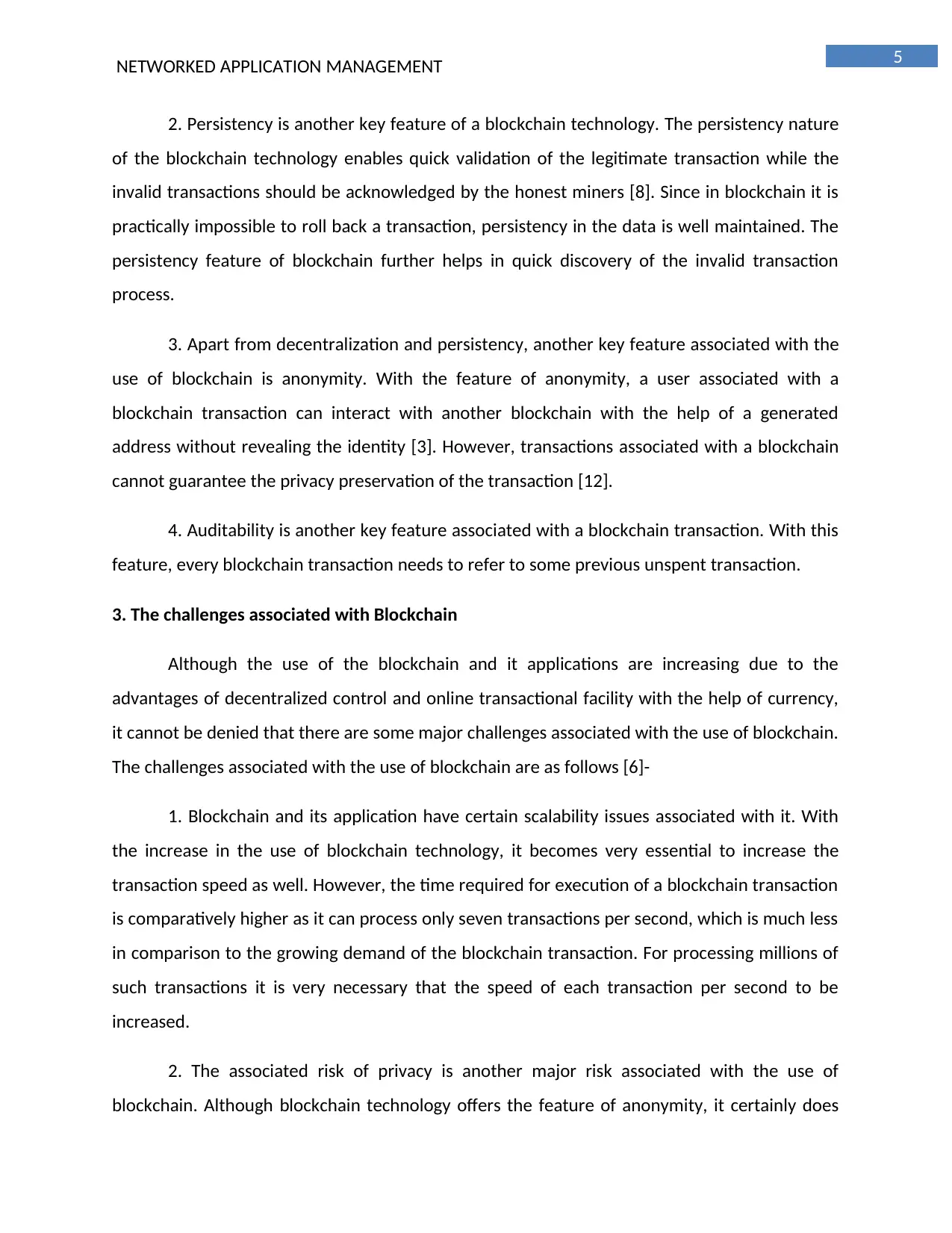
5
NETWORKED APPLICATION MANAGEMENT
2. Persistency is another key feature of a blockchain technology. The persistency nature
of the blockchain technology enables quick validation of the legitimate transaction while the
invalid transactions should be acknowledged by the honest miners [8]. Since in blockchain it is
practically impossible to roll back a transaction, persistency in the data is well maintained. The
persistency feature of blockchain further helps in quick discovery of the invalid transaction
process.
3. Apart from decentralization and persistency, another key feature associated with the
use of blockchain is anonymity. With the feature of anonymity, a user associated with a
blockchain transaction can interact with another blockchain with the help of a generated
address without revealing the identity [3]. However, transactions associated with a blockchain
cannot guarantee the privacy preservation of the transaction [12].
4. Auditability is another key feature associated with a blockchain transaction. With this
feature, every blockchain transaction needs to refer to some previous unspent transaction.
3. The challenges associated with Blockchain
Although the use of the blockchain and it applications are increasing due to the
advantages of decentralized control and online transactional facility with the help of currency,
it cannot be denied that there are some major challenges associated with the use of blockchain.
The challenges associated with the use of blockchain are as follows [6]-
1. Blockchain and its application have certain scalability issues associated with it. With
the increase in the use of blockchain technology, it becomes very essential to increase the
transaction speed as well. However, the time required for execution of a blockchain transaction
is comparatively higher as it can process only seven transactions per second, which is much less
in comparison to the growing demand of the blockchain transaction. For processing millions of
such transactions it is very necessary that the speed of each transaction per second to be
increased.
2. The associated risk of privacy is another major risk associated with the use of
blockchain. Although blockchain technology offers the feature of anonymity, it certainly does
NETWORKED APPLICATION MANAGEMENT
2. Persistency is another key feature of a blockchain technology. The persistency nature
of the blockchain technology enables quick validation of the legitimate transaction while the
invalid transactions should be acknowledged by the honest miners [8]. Since in blockchain it is
practically impossible to roll back a transaction, persistency in the data is well maintained. The
persistency feature of blockchain further helps in quick discovery of the invalid transaction
process.
3. Apart from decentralization and persistency, another key feature associated with the
use of blockchain is anonymity. With the feature of anonymity, a user associated with a
blockchain transaction can interact with another blockchain with the help of a generated
address without revealing the identity [3]. However, transactions associated with a blockchain
cannot guarantee the privacy preservation of the transaction [12].
4. Auditability is another key feature associated with a blockchain transaction. With this
feature, every blockchain transaction needs to refer to some previous unspent transaction.
3. The challenges associated with Blockchain
Although the use of the blockchain and it applications are increasing due to the
advantages of decentralized control and online transactional facility with the help of currency,
it cannot be denied that there are some major challenges associated with the use of blockchain.
The challenges associated with the use of blockchain are as follows [6]-
1. Blockchain and its application have certain scalability issues associated with it. With
the increase in the use of blockchain technology, it becomes very essential to increase the
transaction speed as well. However, the time required for execution of a blockchain transaction
is comparatively higher as it can process only seven transactions per second, which is much less
in comparison to the growing demand of the blockchain transaction. For processing millions of
such transactions it is very necessary that the speed of each transaction per second to be
increased.
2. The associated risk of privacy is another major risk associated with the use of
blockchain. Although blockchain technology offers the feature of anonymity, it certainly does
⊘ This is a preview!⊘
Do you want full access?
Subscribe today to unlock all pages.

Trusted by 1+ million students worldwide
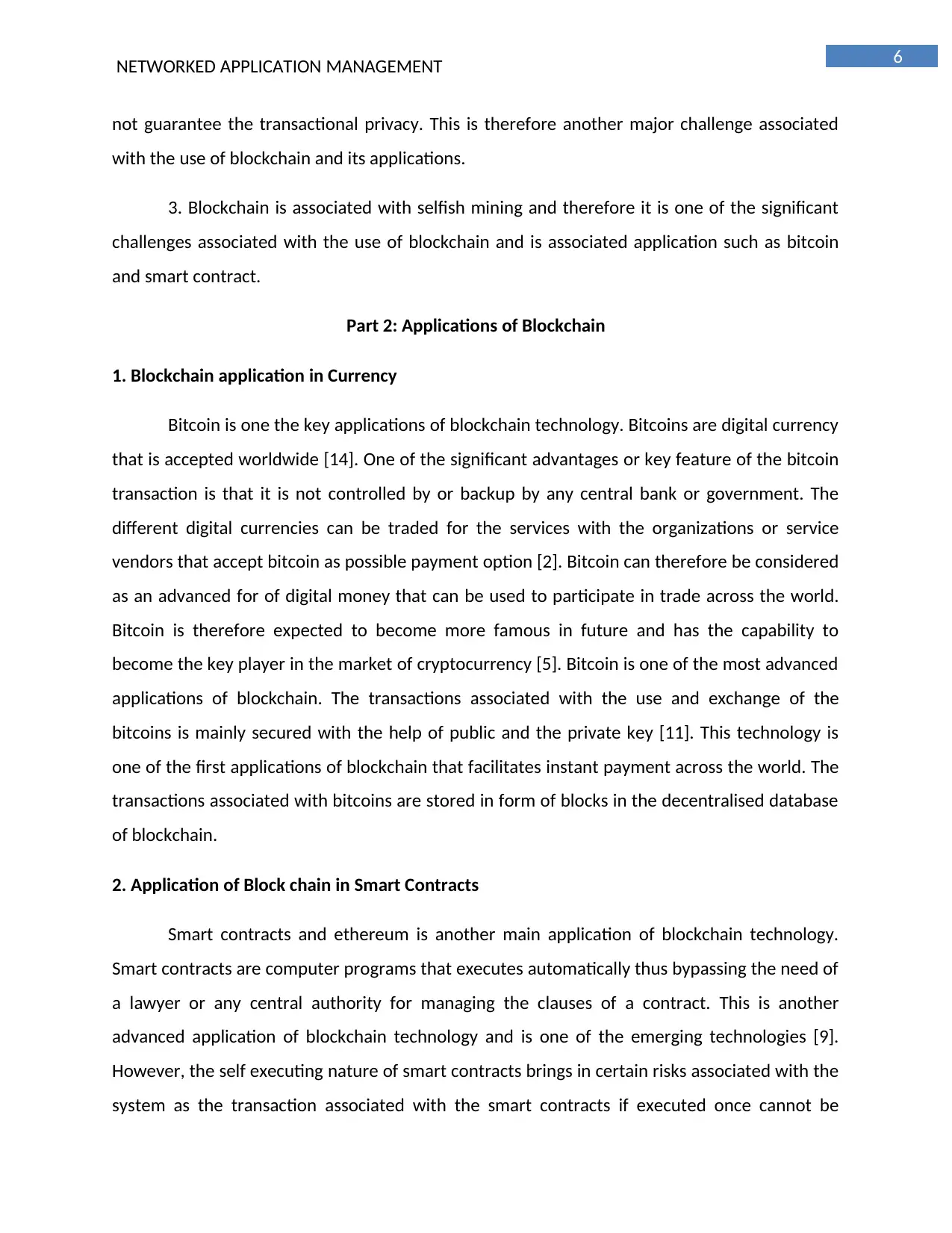
6
NETWORKED APPLICATION MANAGEMENT
not guarantee the transactional privacy. This is therefore another major challenge associated
with the use of blockchain and its applications.
3. Blockchain is associated with selfish mining and therefore it is one of the significant
challenges associated with the use of blockchain and is associated application such as bitcoin
and smart contract.
Part 2: Applications of Blockchain
1. Blockchain application in Currency
Bitcoin is one the key applications of blockchain technology. Bitcoins are digital currency
that is accepted worldwide [14]. One of the significant advantages or key feature of the bitcoin
transaction is that it is not controlled by or backup by any central bank or government. The
different digital currencies can be traded for the services with the organizations or service
vendors that accept bitcoin as possible payment option [2]. Bitcoin can therefore be considered
as an advanced for of digital money that can be used to participate in trade across the world.
Bitcoin is therefore expected to become more famous in future and has the capability to
become the key player in the market of cryptocurrency [5]. Bitcoin is one of the most advanced
applications of blockchain. The transactions associated with the use and exchange of the
bitcoins is mainly secured with the help of public and the private key [11]. This technology is
one of the first applications of blockchain that facilitates instant payment across the world. The
transactions associated with bitcoins are stored in form of blocks in the decentralised database
of blockchain.
2. Application of Block chain in Smart Contracts
Smart contracts and ethereum is another main application of blockchain technology.
Smart contracts are computer programs that executes automatically thus bypassing the need of
a lawyer or any central authority for managing the clauses of a contract. This is another
advanced application of blockchain technology and is one of the emerging technologies [9].
However, the self executing nature of smart contracts brings in certain risks associated with the
system as the transaction associated with the smart contracts if executed once cannot be
NETWORKED APPLICATION MANAGEMENT
not guarantee the transactional privacy. This is therefore another major challenge associated
with the use of blockchain and its applications.
3. Blockchain is associated with selfish mining and therefore it is one of the significant
challenges associated with the use of blockchain and is associated application such as bitcoin
and smart contract.
Part 2: Applications of Blockchain
1. Blockchain application in Currency
Bitcoin is one the key applications of blockchain technology. Bitcoins are digital currency
that is accepted worldwide [14]. One of the significant advantages or key feature of the bitcoin
transaction is that it is not controlled by or backup by any central bank or government. The
different digital currencies can be traded for the services with the organizations or service
vendors that accept bitcoin as possible payment option [2]. Bitcoin can therefore be considered
as an advanced for of digital money that can be used to participate in trade across the world.
Bitcoin is therefore expected to become more famous in future and has the capability to
become the key player in the market of cryptocurrency [5]. Bitcoin is one of the most advanced
applications of blockchain. The transactions associated with the use and exchange of the
bitcoins is mainly secured with the help of public and the private key [11]. This technology is
one of the first applications of blockchain that facilitates instant payment across the world. The
transactions associated with bitcoins are stored in form of blocks in the decentralised database
of blockchain.
2. Application of Block chain in Smart Contracts
Smart contracts and ethereum is another main application of blockchain technology.
Smart contracts are computer programs that executes automatically thus bypassing the need of
a lawyer or any central authority for managing the clauses of a contract. This is another
advanced application of blockchain technology and is one of the emerging technologies [9].
However, the self executing nature of smart contracts brings in certain risks associated with the
system as the transaction associated with the smart contracts if executed once cannot be
Paraphrase This Document
Need a fresh take? Get an instant paraphrase of this document with our AI Paraphraser
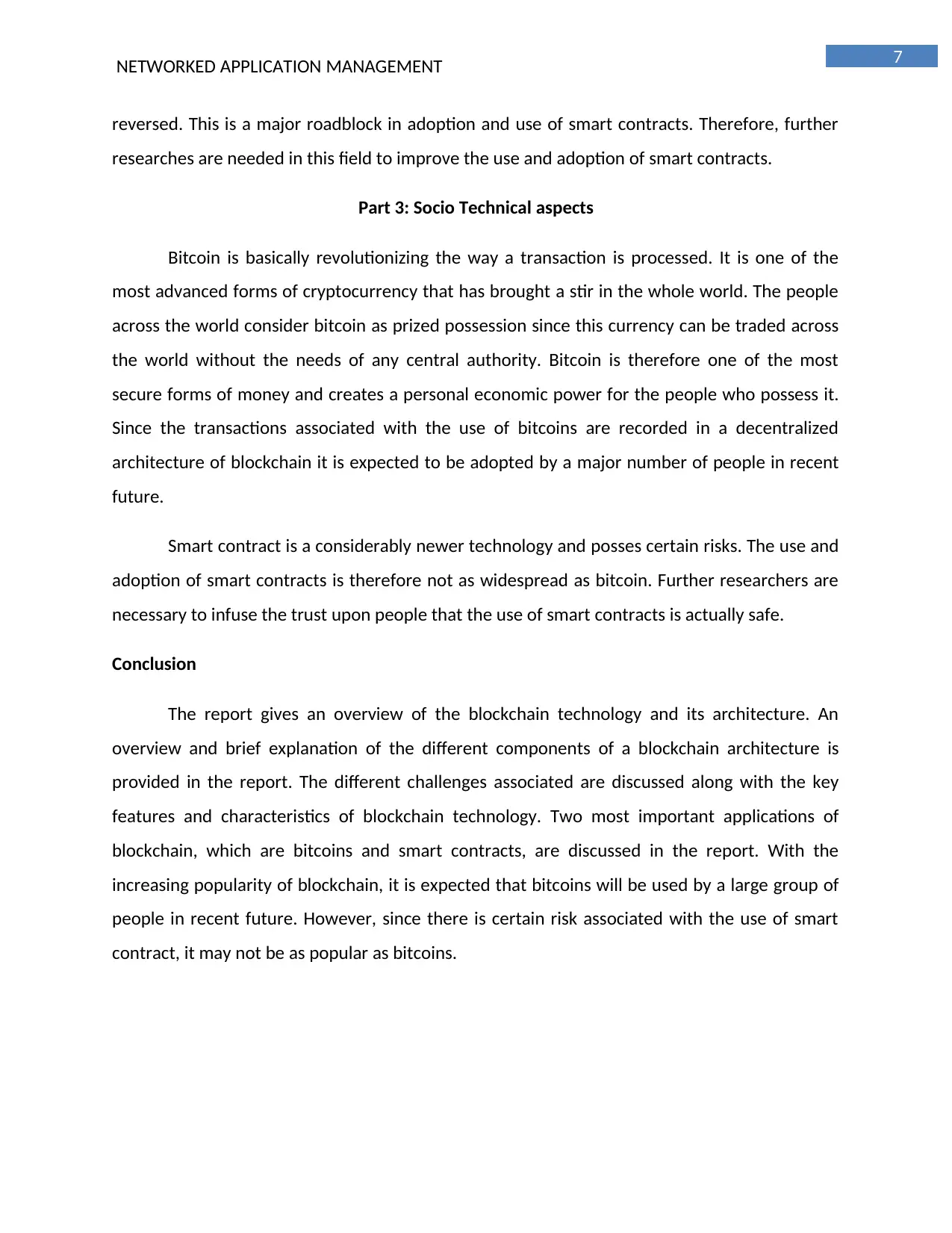
7
NETWORKED APPLICATION MANAGEMENT
reversed. This is a major roadblock in adoption and use of smart contracts. Therefore, further
researches are needed in this field to improve the use and adoption of smart contracts.
Part 3: Socio Technical aspects
Bitcoin is basically revolutionizing the way a transaction is processed. It is one of the
most advanced forms of cryptocurrency that has brought a stir in the whole world. The people
across the world consider bitcoin as prized possession since this currency can be traded across
the world without the needs of any central authority. Bitcoin is therefore one of the most
secure forms of money and creates a personal economic power for the people who possess it.
Since the transactions associated with the use of bitcoins are recorded in a decentralized
architecture of blockchain it is expected to be adopted by a major number of people in recent
future.
Smart contract is a considerably newer technology and posses certain risks. The use and
adoption of smart contracts is therefore not as widespread as bitcoin. Further researchers are
necessary to infuse the trust upon people that the use of smart contracts is actually safe.
Conclusion
The report gives an overview of the blockchain technology and its architecture. An
overview and brief explanation of the different components of a blockchain architecture is
provided in the report. The different challenges associated are discussed along with the key
features and characteristics of blockchain technology. Two most important applications of
blockchain, which are bitcoins and smart contracts, are discussed in the report. With the
increasing popularity of blockchain, it is expected that bitcoins will be used by a large group of
people in recent future. However, since there is certain risk associated with the use of smart
contract, it may not be as popular as bitcoins.
NETWORKED APPLICATION MANAGEMENT
reversed. This is a major roadblock in adoption and use of smart contracts. Therefore, further
researches are needed in this field to improve the use and adoption of smart contracts.
Part 3: Socio Technical aspects
Bitcoin is basically revolutionizing the way a transaction is processed. It is one of the
most advanced forms of cryptocurrency that has brought a stir in the whole world. The people
across the world consider bitcoin as prized possession since this currency can be traded across
the world without the needs of any central authority. Bitcoin is therefore one of the most
secure forms of money and creates a personal economic power for the people who possess it.
Since the transactions associated with the use of bitcoins are recorded in a decentralized
architecture of blockchain it is expected to be adopted by a major number of people in recent
future.
Smart contract is a considerably newer technology and posses certain risks. The use and
adoption of smart contracts is therefore not as widespread as bitcoin. Further researchers are
necessary to infuse the trust upon people that the use of smart contracts is actually safe.
Conclusion
The report gives an overview of the blockchain technology and its architecture. An
overview and brief explanation of the different components of a blockchain architecture is
provided in the report. The different challenges associated are discussed along with the key
features and characteristics of blockchain technology. Two most important applications of
blockchain, which are bitcoins and smart contracts, are discussed in the report. With the
increasing popularity of blockchain, it is expected that bitcoins will be used by a large group of
people in recent future. However, since there is certain risk associated with the use of smart
contract, it may not be as popular as bitcoins.
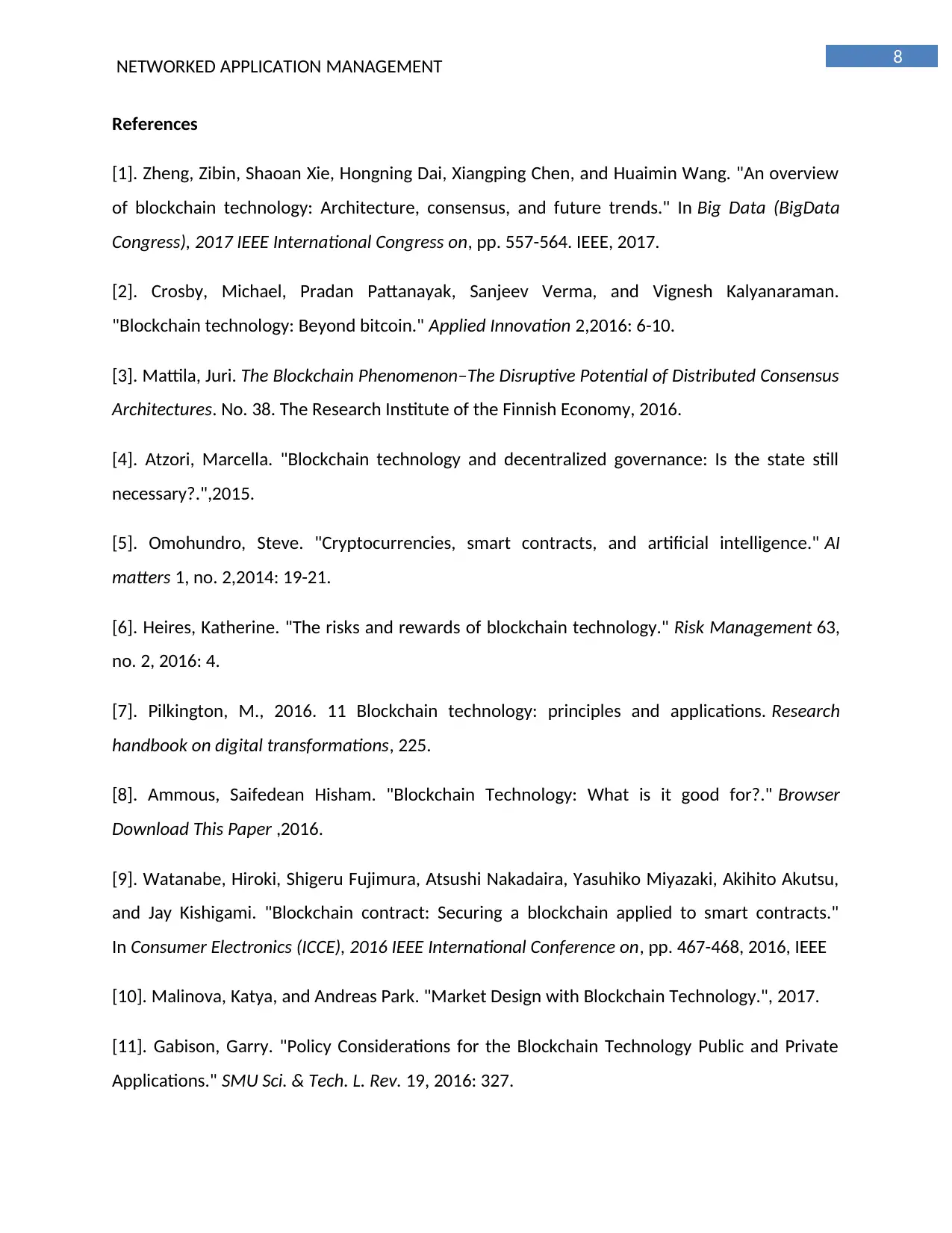
8
NETWORKED APPLICATION MANAGEMENT
References
[1]. Zheng, Zibin, Shaoan Xie, Hongning Dai, Xiangping Chen, and Huaimin Wang. "An overview
of blockchain technology: Architecture, consensus, and future trends." In Big Data (BigData
Congress), 2017 IEEE International Congress on, pp. 557-564. IEEE, 2017.
[2]. Crosby, Michael, Pradan Pattanayak, Sanjeev Verma, and Vignesh Kalyanaraman.
"Blockchain technology: Beyond bitcoin." Applied Innovation 2,2016: 6-10.
[3]. Mattila, Juri. The Blockchain Phenomenon–The Disruptive Potential of Distributed Consensus
Architectures. No. 38. The Research Institute of the Finnish Economy, 2016.
[4]. Atzori, Marcella. "Blockchain technology and decentralized governance: Is the state still
necessary?.",2015.
[5]. Omohundro, Steve. "Cryptocurrencies, smart contracts, and artificial intelligence." AI
matters 1, no. 2,2014: 19-21.
[6]. Heires, Katherine. "The risks and rewards of blockchain technology." Risk Management 63,
no. 2, 2016: 4.
[7]. Pilkington, M., 2016. 11 Blockchain technology: principles and applications. Research
handbook on digital transformations, 225.
[8]. Ammous, Saifedean Hisham. "Blockchain Technology: What is it good for?." Browser
Download This Paper ,2016.
[9]. Watanabe, Hiroki, Shigeru Fujimura, Atsushi Nakadaira, Yasuhiko Miyazaki, Akihito Akutsu,
and Jay Kishigami. "Blockchain contract: Securing a blockchain applied to smart contracts."
In Consumer Electronics (ICCE), 2016 IEEE International Conference on, pp. 467-468, 2016, IEEE
[10]. Malinova, Katya, and Andreas Park. "Market Design with Blockchain Technology.", 2017.
[11]. Gabison, Garry. "Policy Considerations for the Blockchain Technology Public and Private
Applications." SMU Sci. & Tech. L. Rev. 19, 2016: 327.
NETWORKED APPLICATION MANAGEMENT
References
[1]. Zheng, Zibin, Shaoan Xie, Hongning Dai, Xiangping Chen, and Huaimin Wang. "An overview
of blockchain technology: Architecture, consensus, and future trends." In Big Data (BigData
Congress), 2017 IEEE International Congress on, pp. 557-564. IEEE, 2017.
[2]. Crosby, Michael, Pradan Pattanayak, Sanjeev Verma, and Vignesh Kalyanaraman.
"Blockchain technology: Beyond bitcoin." Applied Innovation 2,2016: 6-10.
[3]. Mattila, Juri. The Blockchain Phenomenon–The Disruptive Potential of Distributed Consensus
Architectures. No. 38. The Research Institute of the Finnish Economy, 2016.
[4]. Atzori, Marcella. "Blockchain technology and decentralized governance: Is the state still
necessary?.",2015.
[5]. Omohundro, Steve. "Cryptocurrencies, smart contracts, and artificial intelligence." AI
matters 1, no. 2,2014: 19-21.
[6]. Heires, Katherine. "The risks and rewards of blockchain technology." Risk Management 63,
no. 2, 2016: 4.
[7]. Pilkington, M., 2016. 11 Blockchain technology: principles and applications. Research
handbook on digital transformations, 225.
[8]. Ammous, Saifedean Hisham. "Blockchain Technology: What is it good for?." Browser
Download This Paper ,2016.
[9]. Watanabe, Hiroki, Shigeru Fujimura, Atsushi Nakadaira, Yasuhiko Miyazaki, Akihito Akutsu,
and Jay Kishigami. "Blockchain contract: Securing a blockchain applied to smart contracts."
In Consumer Electronics (ICCE), 2016 IEEE International Conference on, pp. 467-468, 2016, IEEE
[10]. Malinova, Katya, and Andreas Park. "Market Design with Blockchain Technology.", 2017.
[11]. Gabison, Garry. "Policy Considerations for the Blockchain Technology Public and Private
Applications." SMU Sci. & Tech. L. Rev. 19, 2016: 327.
⊘ This is a preview!⊘
Do you want full access?
Subscribe today to unlock all pages.

Trusted by 1+ million students worldwide
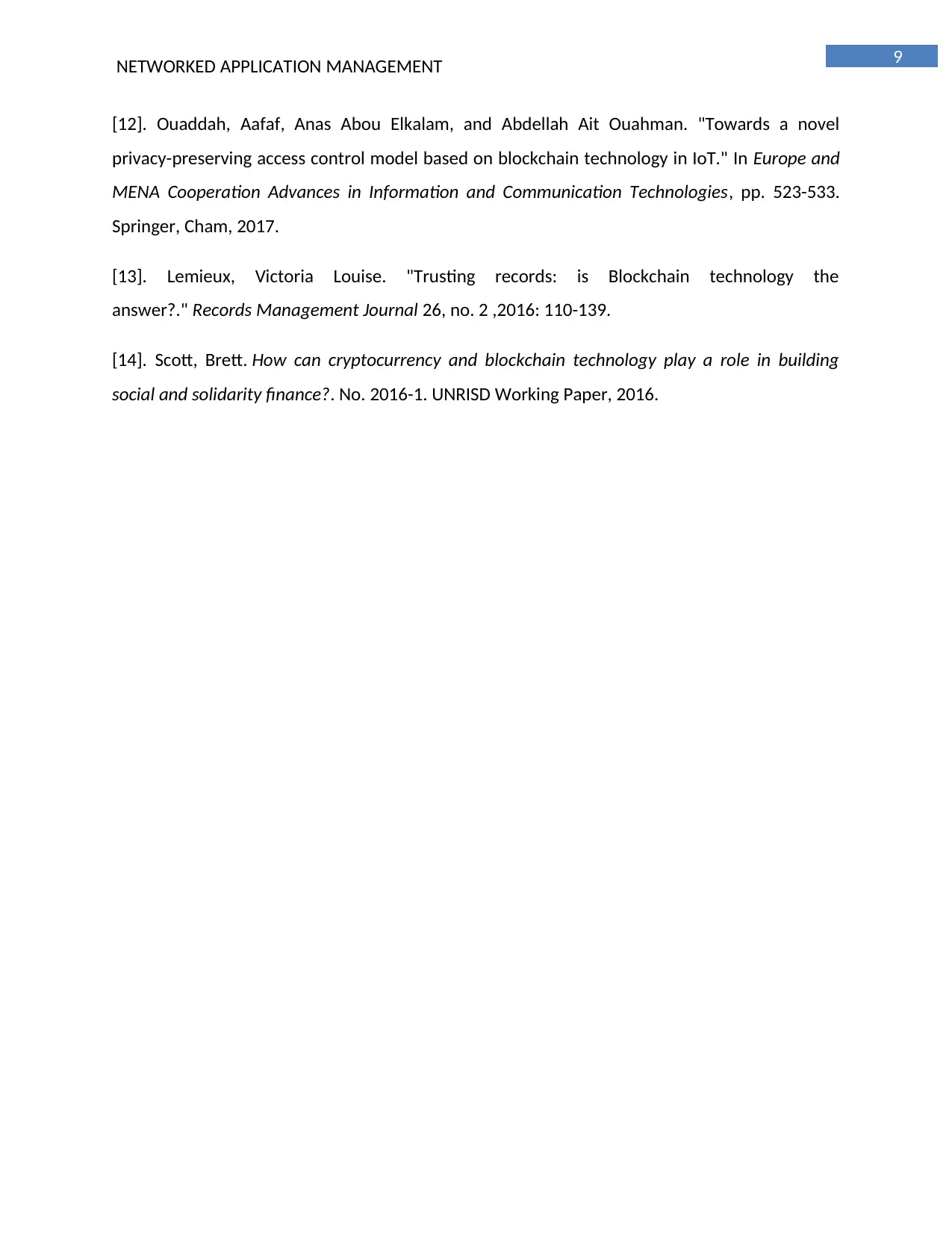
9
NETWORKED APPLICATION MANAGEMENT
[12]. Ouaddah, Aafaf, Anas Abou Elkalam, and Abdellah Ait Ouahman. "Towards a novel
privacy-preserving access control model based on blockchain technology in IoT." In Europe and
MENA Cooperation Advances in Information and Communication Technologies, pp. 523-533.
Springer, Cham, 2017.
[13]. Lemieux, Victoria Louise. "Trusting records: is Blockchain technology the
answer?." Records Management Journal 26, no. 2 ,2016: 110-139.
[14]. Scott, Brett. How can cryptocurrency and blockchain technology play a role in building
social and solidarity finance?. No. 2016-1. UNRISD Working Paper, 2016.
NETWORKED APPLICATION MANAGEMENT
[12]. Ouaddah, Aafaf, Anas Abou Elkalam, and Abdellah Ait Ouahman. "Towards a novel
privacy-preserving access control model based on blockchain technology in IoT." In Europe and
MENA Cooperation Advances in Information and Communication Technologies, pp. 523-533.
Springer, Cham, 2017.
[13]. Lemieux, Victoria Louise. "Trusting records: is Blockchain technology the
answer?." Records Management Journal 26, no. 2 ,2016: 110-139.
[14]. Scott, Brett. How can cryptocurrency and blockchain technology play a role in building
social and solidarity finance?. No. 2016-1. UNRISD Working Paper, 2016.
1 out of 10
Related Documents
Your All-in-One AI-Powered Toolkit for Academic Success.
+13062052269
info@desklib.com
Available 24*7 on WhatsApp / Email
![[object Object]](/_next/static/media/star-bottom.7253800d.svg)
Unlock your academic potential
Copyright © 2020–2025 A2Z Services. All Rights Reserved. Developed and managed by ZUCOL.




